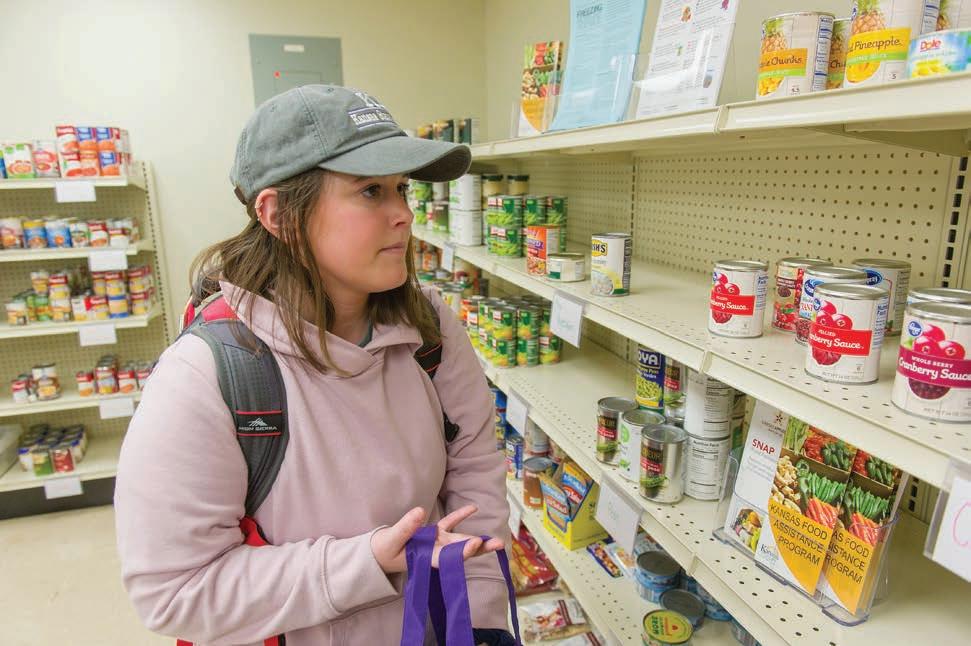
7 minute read
Big 12 adds new schools
Honoring more greats: Four Wildcats, Steve Fritz ’93, Jordy Nelson ’07, Terence Newman ’02 and Darren Sproles ’05, were inducted into the Kansas Sports Hall of Fame 2021 class in October. Bill Snyder, a 2006 class inductee, represented Sproles and Newman at the ceremony.
K-State launches the Women in Business initiative through the College of Business
Advertisement
The College of Business Administration at K-State launched a Women in Business initiative with a career summit on Oct. 22, 2021.
K-State’s Women in Business initiative is supported by numerous College of Business donors and advisers, including several female executives who are K-State alumni — Candace Hart Duncan ’75, former managing partner KPMG LLP; Carolyn Thompson ’12, founder and CEO of Merito Group; and Leanne Caret ’88, CEO of Boeing Defense, Space and Security. Caret served as the keynote speaker.
“The women of K-State today will be the future changemakers, CEOs and business leaders of tomorrow,” said Marcia Hornung, Menard Family Director, Center for Principled Business. “The K-State College of Business strives to foster an inclusive learning environment for students throughout their time at K-State and beyond. As a part of our strategic plan for diversity, equity, inclusion and belonging, we are thrilled to launch the Women in Business Initiative.”
Hosted by the Center for Principled Business, this new initiative serves current college students, alumni, working professionals, as well as regional high school students. The Women in Business Initiative fosters a network of innovation and collaboration through academic and co-curricular learning opportunities, and supports business research to advance women in the workplace.
Big 12 Conference adds four new members starting no later than the 2024-2025 athletic year
The Big 12 Conference, in September, announced that Brigham Young University, the University of Central Florida, the University of Cincinnati and the University of Houston will become members no later than the 2024-25 athletic year.
This marks the second time in the Conference’s 26-year history that new members were added. Baylor, Iowa State, K-State, Kansas, Oklahoma State and Texas Tech have been members since the Big 12 began in 1996, with TCU and West Virginia joining in 2011.
“The Big 12 presidents and chancellors entered this process with the singular focus to strengthen and stabilize the Conference,” noted Lawrence Schovanec, chair of the Big 12 board of directors and president of Texas Tech University. “With the addition of these four tradition-rich institutions we have set the Big 12 on a continued path of success. We look forward to having BYU, UCF, Cincinnati and Houston under the Big 12 banner, both athletically and academically.”
These actions were in accordance with Big 12 Conference Bylaw 1.5.2.b.3 requiring an a rmative vote of a supermajority of directors, and was approved unanimously by the eight continuing members.
“[This] vote solidi es the long-term trajectory of the Big 12 Conference,” stated Commissioner Bob Bowlsby. “I applaud the e orts of our presidents, chancellors and athletics directors of our continuing members to expeditiously consider and take this action. The addition of these four ne institutions ensures the continued success of the Big 12 at the highest levels of intercollegiate athletics competition.”
Founded in 1875, Brigham Young University is located in Provo, Utah. The campus is home to 33,181 undergraduate students, pursuing degrees in 186 majors. Athletically, the Cougars compete in 21 sports. They have won 12 NCAA titles all-time, claimed 296 conference championships; and have been home to 1,385 All-Americans, one Heisman Trophy winner and 75 Olympians.
Located in Orlando, Florida, the University of Central Florida is a metropolitan research university that was founded in 1963. UCF is recognized nationally for its innovation, a ordability and for fostering social mobility. With approximately 70,000 students, 13 colleges and 230 degree programs, the university helps to develop the skilled talent needed to advance industry and solve society’s greatest challenges.
The University of Cincinnati is a public research university with an enrollment of 46,798. Founded in 1819, UC o ers 414 degree programs. Over its athletics history, Bearcat teams have combined to win 116 conference championships. The men’s basketball program has accounted for 41 conference titles and two national championships. This past season, the UC football team took a perfect record and a #8 CFP ranking into a Peach Bowl date with Georgia.
Established in 1927, the University of Houston is a Tier I research institution, with over 47,000 students enrolled in its 408 undergraduate, masters and PhD programs. Its athletic success includes 158 conference titles, 17 NCAA team champions, 1,059 All-Americans, 63 Olympians and one Heisman Trophy winner. Last season was highlighted by the men’s basketball team’s run to the Final Four.

Hometown Pride: A new mural highlighting the charm and partnerships of Manhattan, Kansas, Fort Riley and K-State graces the west wall of the Manhattan Area Chamber of Commerce’s building on Poyntz Avenue. The mural was painted by Carr, Kerr, & Co. as part of the Incite MHK project. Learn more at incitemhk.org.

$3.43 million NIH grant to create core research facility at College of Veterinary Medicine
Like a hub that connects the spokes of a wheel, the College of Veterinary Medicine is creating a new research center that brings together ve highly focused laboratories at K-State. The core laboratory is being made possible by a $3.43 million grant from the National Institutes of Health and will strengthen research e ciency and collaboration among K-State scientists and beyond.
The core-facility suite is the nal element of a three-phase renovation at the College of Veterinary Medicine. Phase 1 delivered the Boehringer Ingelheim Auditorium adjacent to Mosier Hall — a 220 seat, contemporary educational space. Phase 2 became the Hill’s Pet Health and Nutrition Center for clinical training and community service, which occupies the rst- oor space created by deconstruction of the outdated, two-story auditorium. Phase 3, the 5,000-square-foot research laboratory, will occupy the second oor of the old auditorium space.
“This new core research facility strategically combines ve key disciplines: animal model/pathology, molecular and cellular biology, microscopic imaging, ow cytometry and cell sorting, and next-generation sequencing,” said Bonnie Rush, dean of the College of Veterinary Medicine.
The new research facility represents a critical component of the university’s research infrastructure to support infectious disease studies.
It will provide direct support of K-State’s Center on Emerging and Zoonotic Infectious Diseases, or CEZID, which was created by an $11.3 million grant in 2020 through the NIH’s Center of Biomedical Research Excellence, and nearby federal facilities in Manhattan that include the U.S. Department of Agriculture’s National Bio and Agro-defense Facility, or NBAF, and Arthropod-Borne Animal Diseases Research Unit.
Currently, existing laboratories are isolated from each other, spread across three buildings and in some cases, hosted by individual faculty members, creating a burden for the host scientist and ine cient work ow for all parties, Rush said. Consolidating these individual facilities into a combined core will improve laboratory access, optimize research work ows and experimental outcomes, and provide coordinated training opportunities for students.
“This will give our university a modern biomedical research facility with advanced instrumentation and technical support to foster collaborative, transdisciplinary science across the university and beyond,” Rush said. “This is critical to promoting a robust research and training environment where researchers can answer the most challenging and urgent biomedical questions of our time.”
Rush said the latest NIH grant will support CEZID and collaborating scientists to advance the discovery and molecular characterization of infectious pathogens and diseases a ecting animals and people. Projects within this new core research facility will bridge areas of excellence across K-State colleges that conduct STEM research. These projects examine crosscutting themes, such as virulence factors and host-pathogen interactions of pathogens of signi cance for human health, employing in vitro systems and animal models.”
The newly funded, core-facility suite will assemble state-of-the-art technologies in a single location to facilitate the delivery of coordinated services for academic, corporate and federal researchers in imaging and molecular analyses, providing a complete range of services from whole tissues to single-cell nucleic acid analyses.
Currently, CEZID has collaborative partnerships with the University of Missouri, Columbia; MRI Global in Kansas City, Missouri; and regional pharmaceutical companies in the Kansas City Animal Health Corridor, such as Boehringer Ingelheim Animal Health in St. Joseph, Missouri, CEVA Animal Health in Lenexa and Elanco Animal Health in Overland Park.
Rush said the proposed plan is to complete renovation and then occupy the consolidated biomedical core facilities by the fourth quarter of 2023.










